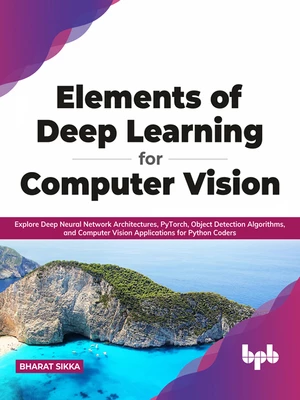Conceptualizing deep learning in computer vision applications using PyTorch and Python libraries. Key Features. ● Covers a variety of computer vision projects, including face recognition and object recognition such as Yolo, Faster R-CNN. ● Includes graphical representations and illustrations of neural networks and teaches how to program them. ● Includes deep learning techniques and architectures introduced by Microsoft, Google, and the University of Oxford. Description. Elements of Deep Learning for Computer Vision gives a thorough understanding of deep learning and provides highly accurate computer vision solutions while using libraries like PyTorch. This book introduces you to Deep Learning and explains all the concepts required to understand the basic working, development, and tuning of a neural network using Pytorch. The book then addresses the field of computer vision using two libraries, including the Python wrapper/version of OpenCV and PIL. After establishing and understanding both the primary concepts, the book addresses them together by explaining Convolutional Neural Networks(CNNs). CNNs are further elaborated using top industry standards and research to explain how they provide complicated Object Detection in images and videos, while also explaining their evaluation. Towards the end, the book explains how to develop a fully functional object detection model, including its deployment over APIs. By the end of this book, you are well-equipped with the role of deep learning in the field of computer vision along with a guided process to design deep learning solutions. What you will learn ● Get to know the mechanism of deep learning and how neural networks operate. ● Learn to develop a highly accurate neural network model. ● Access to rich Python libraries to address computer vision challenges. ● Build deep learning models using PyTorch and learn how to deploy using the API. ● Learn to develop Object Detection and Face Recognition models along with their deployment. Who this book is for. This book is for the readers who aspire to gain a strong fundamental understanding of how to infuse deep learning into computer vision and image processing applications. Readers are expected to have intermediate Python skills. No previous knowledge of PyTorch and Computer Vision is required. Table of Contents 1. An Introduction to Deep Learning. 2. Supervised Learning. 3. Gradient Descent. 4. OpenCV with Python. 5. Python Imaging Library and Pillow. 6. Introduction to Convolutional Neural Networks. 7. GoogLeNet, VGGNet, and ResNet. 8. Understanding Object Detection. 9. Popular Algorithms for Object Detection. 10. Faster RCNN with PyTorch and YoloV4 with Darknet. 11. Comparing Algorithms and API Deployment with Flask. 12. Applications in Real World. About the Authors Bharat Sikka is a data scientist based in Mumbai, India. Over the years, he has worked on implementing algorithms like YOLOv3/v4, Faster-RCNN, Mask-RCNN, among others. He is currently working as a data scientist at the State Bank of India. He also has a thorough knowledge and understanding of various programming languages such as Python, R, MATLAB, and Octave for Machine Learning, Deep Learning, Data Visualization and Analysis in Python, R, and Power BI, Tableau. He holds an MS degree in Data Science and Analytics from Royal Holloway, University of London, and a BTech degree in Information Technology from Symbiosis International University and has earned multiple certifications, including MOOCs in varied fields, including machine learning. He is a science fiction fanatic, loves to travel, and is a great cook. Blog links : https://github.com/bharatsikka. LinkedIn Profile : www.linkedin.com/in/bharat-sikka
Price history
Oct 2, 2022
€14.37

